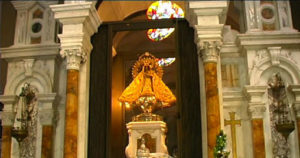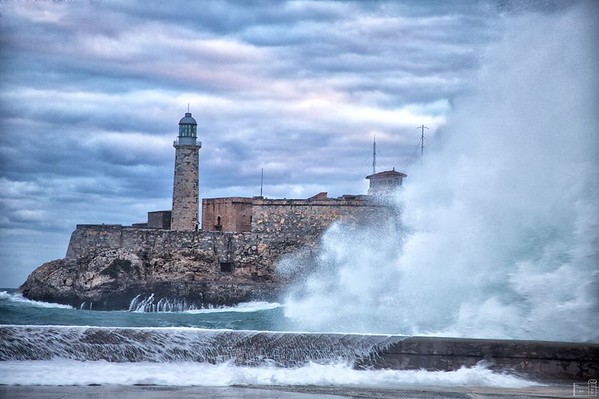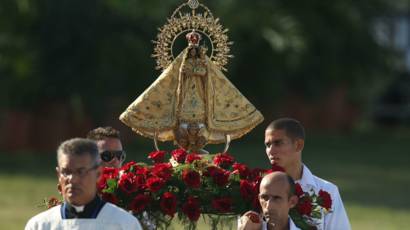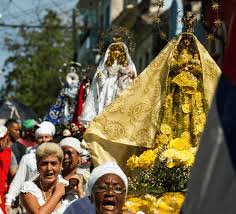COMIENZAN LAS CELEBRACIONES EN DEVOCIÓN A NUESTRA VIRGEN DE LA CARIDAD DEL COBRE
En una Tradición arraigada en el pueblo cubano que comienzan el 7 de Septiembre y que termina hoy (Septiembre 8) en cada rincón del mundo, se celebra una fecha más de la historica aparición de la imagen de la Virgen de la Caridad del Cobre, la de todos los cubanos y tantos devotos a su recuerdo y protección.
Nuestra Señora de la Caridad del Cobre, o la Virgen de la Caridad del Cobre, Caridad del Cobre o simplemente “Cachita”, es una de las advocaciones de la Virgen María y es la Patrona de Cuba.
La imagen mariana se venera en la Basílica Santuario Nacional de Nuestra Señora de la Caridad del Cobre en Santiago de Cuba.
HISTORIA DE LA APARACION DE LA VIRGEN
Según recuentos de la época, su imagen apareció en 1612 o principios de 1613 de abril, en la Bahía de Nipe, la mayor de Cuba, situada en la costa norte de la región oriental de la isla. Fue avistada por tres esclavos: un muchacho negro de 10 años (Juan Moreno) y dos hermanos de pura sangre india (Juan y Rodrigo de Hoyos), que trabajaban como esclavos en las minas de cobre de la región. El trío ha quedado bautizado en la imaginería cubana como “los tres Juanes”.
En un relato que se conserva en el Archivo de Indias de Sevilla, hecho bajo juramento eclesiástico “setenta y cinco años después del suceso”, el esclavo negro Juan Moreno contó cómo ocurrieron los hechos. Los jóvenes, que habían ido en busca de sal, divisaron la imagen de la Virgen con el Niño Jesús en brazos –la misma que hoy es objeto de veneración por los cubanos– que se acercaba flotando en una tabla, donde podía leerse la frase “Yo soy la Virgen de la Caridad”.
El santuario inicial se construyó de manera improvisada, empleando hojas de guano y tablas. Tras múltiples sucesos misteriosos ocurridos en torno a la imagen, ésta fue llevada al que sería su santuario definitivo, a poca distancia de allí, en la cima de una loma cercana a las minas de cobre.
Es la Patrona de Cuba, y este solemne nombramiento fue proclamado por el papa Benedicto XV en el año 1916. La imagen es una coronada canónicamente fue proclamado por el papa Pío XI el 30 diciembre de 1936. Posteriormente, en un viaje realizado por Juan Pablo II a Cuba en 1998, coronó con gran dignidad a la Virgen como Patrona de Cuba.
PROCLAMACION DE LA VIRGEN COMO PATRONA DE CUBA Y CORONACION
En 1915 los veteranos de la Guerra de Independencia escribieron al papa Benedicto XV pidiendo que proclamara Patrona de Cuba a la Virgen de la Caridad del Cobre. El 10 de mayo de 1916, el papa Benedicto XV declara a la virgen patrona de Cuba. El papa Pío XI autorizó la coronación canónica de la sagrada imagen. Es en la mañana del 20 de diciembre de 1936, cuando se realizó la coronación por el entonces obispo de Santiago de Cuba, Monseñor Valentín Zubizarreta.
Durante las guerras de independencia de Cuba iniciadas en 1868, las tropas del Ejército Libertador de Cuba manifestaban gran devoción por la Virgen de la Caridad y se encomendaban a ella.
En la actualidad, las personas que visitan el Santuario suelen volver a sus hogares con diminutas piedras donde brilla el cobre de la mina. Se dice que quienes las poseen tanto colocadas en vasos de agua, como en bolsillos o bolsos, poseen una especial protección contra los males, pues resultan metafóricos guardianes de un futuro noble en lo personal y familiar.
SANTUARIO DEL COBRE
La Basílica Santuario Nacional de Nuestra Señora de la Caridad del Cobre es uno de los sitios religiosos más venerados por el pueblo cubano. Llegados de diferentes territorios de la nación, los fieles buscan en la Patrona de Cuba, el consuelo espiritual, la solución de sus anhelos y problemas que afectan al ser humano. Situada en El Cobre, municipio de la oriental provincia de Santiago de Cuba, en el promontorio de Santiago del Prado, posee tres naves, con una fachada principal simétrica. Su estructura central concluye en una cúpula, las naves laterales están rematadas por torres donde se enseñorean campanarios en un nivel más bajo.
El actual Santuario del Cobre, que ofrece misa cada mañana, se inauguró el 8 de septiembre de 1927 y tiene un altar de plata maciza y otros objetos ornamentales de gran valor. Debajo del Camarín de la Virgen se encuentra la denominada Capilla de los Milagros, un pequeño recinto donde los creyentes depositan disímiles ofrendas: joyas de oro y piedras preciosas, muletas, entre otras riquezas de valores. Unas 500 personas acuden al lugar cada día. Los peregrinos se llevan consigo diminutas piedras de la mina, donde brillan las partículas de cobre y las conservan en sus casas en vasos de agua, bolsillos o bolsos, como protección contra los males o quizás como buena luz para el futuro personal y familiar. El papa Pablo VI envió el 30 de diciembre de 1977 como delegado suyo, al cardenal Bernardin Gantin, portador de la Bula Papal, por la que se proclamó Basílica Menor al hasta entonces Santuario Nacional.
Se sabe que la Virgen de la Caridad ha salido de su santuario sólo en cinco ocasiones:
– 1936 cuando fue coronada por el Arzobispo de Santiago de Cuba.
– 1952 en el Cincuentenario de la República.
– 1959 asiste al Congreso Nacional Católico en La Habana.
– 1998 es coronada por el papa Juan Pablo II en la plaza Antonio Maceo.
– 2011 peregrinación por toda la isla con motivo de la conmemoración del 400 aniversario de su aparición.
El Premio Nobel de Literatura Ernest Hemingway, vinculado afectivamente a Cuba, entregó la medalla que le otorgaba tal distinción a la venerada Patrona. Dijo entonces que lo hacía en reconocimiento al pueblo cubano, inspirador de su obra «El viejo y el mar», por el cual recibió el máximo galardón de la literatura en Estocolmo.
MEDIDAS TOMADAS EN LA CELEBRACION EN CUBA POR LA EPIDEMIA
La Iglesia Católica en Cuba celebrará el día de la Virgen de la Caridad del Cobre con algunas variaciones en el programa tradicional y apegada a las normas establecidas para enfrentar la pandemia del Covid-19, según informó Dionisio García Ibáñez, arzobispo de Santiago de Cuba.
Este 8 de septiembre, las calles de Cuba se visten con el amarillo de telas y girasoles para celebrar a la Virgen de la Caridad del Cobre. Este año, sin embargo, a la Patrona de la Isla no la acompaña su pueblo. Esgrimiendo la pandemia de covid-19, que no da tregua en el país, y a pesar de que no tienen reparos de ver las aglomeraciones en las colas ni de convocar otras manifestaciones “revolucionarias”, las autoridades decidieron restringir las procesiones a pie.
Los cubanos celebran este miércoles el Día de la Virgen de la Caridad del Cobre y la imagen de la Patrona de la Isla lleva dos días saliendo por Santiago de Cuba y se espera que también lo haga hoy, informó la Arquidiócesis de Santiago.
“Todos pensamos que este sería nuevamente un año sin que la imagen querida de la Virgen Peregrina, la Mambisa, la imagen que desde hace siglos se venera en la parroquia de Santo Tomás, saliera a las calles de Santiago de Cuba. Un año de cuidados y restricciones por la pandemia, que no cesa de enlutar y llenar de dolor a tantos cubanos, que no deja de tener en vilo a miles de hombres y mujeres que a riesgo de su salud velan y sanan… Pero la Madre salió a las calles para llegar hasta la puerta del mayor número posible de sus hijos”, dijo la Arquidiócesis.
SINCRETISMO RELIGIOSO
La fiesta de la Virgen de la Caridad del Cobre y la celebración de Oshún, orisha (o santa) de la religión yoruba, se celebran en Cuba el 8 de septiembre bajo un mismo festejo, esto se puede entender como transculturación y sincretismo religioso entre la religión católica y la yoruba que sucedió en la población cubana.
THE CELEBRATIONS BEGIN IN DEVOTION TO OUR VIRGIN OF CHARITY OF COPPER. PHOTOS.
In a Tradition rooted in the Cuban people that begin on September 7 and that ends today (September 8) in every corner of the world, another date is celebrated for the historic appearance of the image of the Virgin of Caridad del Cobre, the of all Cubans and so many devoted to his memory and protection.
Our Lady of Charity of Copper, or the Virgin of Charity of Copper, Charity of Copper or simply “Cachita”, is one of the invocations of the Virgin Mary and is the Patron Saint of Cuba.
The Marian image is venerated in the National Shrine Basilica of Our Lady of Caridad del Cobre in Santiago de Cuba.
HISTORY OF THE APPARITION OF THE VIRGIN
According to accounts of the time, her image appeared in 1612 or early April 1613, in the Nipe Bay, the largest in Cuba, located on the north coast of the eastern region of the island. She was spotted by three slaves: a 10-year-old black boy (Juan Moreno) and two pure-blood Indian brothers (Juan and Rodrigo de Hoyos), who worked as slaves in the copper mines of the region. The trio has been baptized in Cuban imagery as “the three Juanes.”
In a story that is preserved in the Archive of the Indies in Seville, made under ecclesiastical oath “seventy-five years after the event”, the black slave Juan Moreno told how the events occurred. The young people, who had gone in search of salt, saw the image of the Virgin with the Child Jesus in her arms – the same one that today is the object of veneration by the Cubans – that came floating on a table, where the phrase “ I am the Virgin of Charity ”.
The initial sanctuary was built in an improvised way, using guano sheets and boards. After multiple mysterious events that occurred around the image, it was taken to what would be its final sanctuary, a short distance from there, on top of a hill near the copper mines.
She is the Patron Saint of Cuba, and this solemn appointment was proclaimed by Pope Benedict XV in 1916. The image is a canonically crowned one that was proclaimed by Pope Pius XI on December 30, 1936. Later, on a trip made by Juan Pablo II to Cuba in 1998, he crowned Our Lady with great dignity as Patroness of Cuba.
PROCLAMATION OF THE VIRGIN AS PATRON OF CUBA AND CORONATION
In 1915 the veterans of the War of Independence wrote to Pope Benedict XV asking him to proclaim the Virgin of Charity of El Cobre as Patroness of Cuba. On May 10, 1916, Pope Benedict XV declared the patron virgin of Cuba. Pope Pius XI authorized the canonical coronation of the sacred image. It is on the morning of December 20, 1936, when the coronation was carried out by the then bishop of Santiago de Cuba, Monsignor Valentín Zubizarreta.
During the Cuban wars of independence that began in 1868, the troops of the Cuban Liberation Army showed great devotion to the Virgin of Charity and entrusted themselves to her.
Today, people who visit the Sanctuary often return to their homes with tiny stones where the copper from the mine shines. It is said that those who possess them both placed in glasses of water, as in pockets or bags, have special protection against evil since they are metaphorical guardians of a noble future in the personal and family.
SANTUARIO DEL COBRE
The National Shrine Basilica of Our Lady of Charity of El Cobre is one of the most revered religious sites by the Cuban people. Coming from different territories of the nation, the faithful seeks in the Patron Saint of Cuba, her spiritual consolation, the solution of her desires and her problems that affect the human being. Located in El Cobre, a municipality in the eastern province of Santiago de Cuba, on the promontory of Santiago del Prado, it has three naves, with a symmetrical main façade. Its central structure concludes in a dome, the side naves are topped by towers where bell towers dominate at a lower level.
The current Sanctuary of El Cobre, which offers mass every morning, was inaugurated on September 8, 1927, and has a solid silver altar and other ornamental objects of great value. Below the Camarín de la Virgen is the so-called Chapel of Miracles, a small enclosure where believers deposit dissimilar offerings: gold jewelry and precious stones, crutches, among other wealth of values. About 500 people come to the site every day. The pilgrims take with them tiny stones from the mine, where the copper particles shine, and keep them at home in glasses of water, pockets, or bags, as protection against evils or perhaps as good light for the personal and family future. On December 30, 1977, Pope Paul VI sent Cardinal Bernardin Gantin as his delegate, bearer of the Papal Bull, by which the until then National Shrine was proclaimed Minor Basilica.
It is known that the Virgin of Charity has left her sanctuary only five times:
– 1936 when she was crowned by the Archbishop of Santiago de Cuba.
– 1952 on the 50th anniversary of the Republic.
– 1959 she attends the National Catholic Congress in Havana.
– 1998 she is crowned by Pope John Paul II in the Plaza Antonio Maceo.
– 2011 pilgrimage throughout the island to commemorate the 400th anniversary of its appearance.
The Nobel Prize in Literature Ernest Hemingway, affectionately linked to Cuba, presented the medal that conferred such distinction on the venerated Patron. He said then that he did it in recognition of the Cuban people, inspiring his work “The Old Man and the Sea”, for which he received the highest award in literature in Stockholm.
MEASURES TAKEN IN THE CELEBRATION IN CUBA DUE TO THE EPIDEMIC
The Catholic Church in Cuba will celebrate the day of the Virgen de la Caridad del Cobre with some variations in the traditional program and adhering to the norms established to face the Covid-19 pandemic, according to Dionisio García Ibáñez, Archbishop of Santiago de Cuba.
This September 8, the streets of Cuba are dressed in yellow fabrics and sunflowers to celebrate the Virgen de la Caridad del Cobre. This year, however, the Patroness of the Island is not accompanied by her people. Wielding the covid-19 pandemic, which does not give truce in the country, and despite the fact that they have no qualms about seeing the crowds in the queues or calling other “revolutionary” demonstrations, the authorities decided to restrict the processions on foot.
Cubans celebrate this Wednesday the Day of the Virgin of Charity of Copper and the image of the Patron Saint of the Island has been leaving Santiago de Cuba for two days and it is expected that it will also do so today, the Archdiocese of Santiago reported.
“We all think that this would be a year again without the beloved image of the Pilgrim Virgin, the Mambisa, the image that has been venerated in the parish of Santo Tomás for centuries, going out onto the streets of Santiago de Cuba. A year of care and restrictions due to the pandemic, which does not cease to mourn and fill so many Cubans with pain, which continues to have thousands of men and women in suspense who, at the risk of their health, watch and heal … But the Mother went out to the streets to reach the door of as many of their children as possible, “the Archdiocese said.
RELIGIOUS SYNCRETISM
The festival of the Virgen de la Caridad del Cobre and the celebration of Oshún, orisha (or saint) of the Yoruba religion, are celebrated in Cuba on September 8 under the same celebration, this can be understood as transculturation and religious syncretism between the Catholic religion and the Yoruba that happened in the Cuban population.
Agencies/ Wiki/ Memorias Cubans/ Various/ Extractos/ Excerpts/ Internet Photos/ Arnoldo Varona/ www.TheCubanHistory.com
THE CUBAN HISTORY, HOLLYWOOD.



 COMIENZAN las Celebraciones en Devoción a Nuestra Virgen de la Caridad del Cobre. * THE CELEBRATIONS begin in Devotion to Our Virgin of La Caridad del Cobre. PHOTOS.
COMIENZAN las Celebraciones en Devoción a Nuestra Virgen de la Caridad del Cobre. * THE CELEBRATIONS begin in Devotion to Our Virgin of La Caridad del Cobre. PHOTOS.







